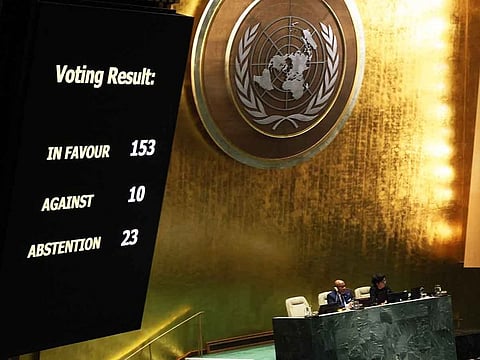UN Gaza resolution exposes aggressor, rather than punish it
Israel ignored multiple efforts by UN to push for ceasefire and is likely to do so again

Back in 1950, the Soviet Union repeatedly used its veto power at the Security Council to bloc all attempts at a ceasefire in the Korean War.
That was at the height of the Cold War, and in response to the Soviets, the US administration of then-president Harry Truman pushed for General Assembly Resolution 377, empowering the General Assembly to take action in the form of “appropriate recommendations,” stepping in to fix what was globally perceived as a Security Council glitch, or failure, at securing world peace.
Those “appropriate recommendations” would be legally non-binding but morally damning for any nation singled out as an aggressor or a threat to world peace. The UNGA resolution, commonly referred to as Uniting for Peace, was passed on 3 November 1950.
By law, UNGA 377 could only be invoked if at least one member state of the Security Council called for a General Assembly session, to be-chaired by the UN Secretary General, who at the time was still the organisation’s founding chief Trygve Lie.
Also Read: How the US can impose a ceasefire in Gaza
Has 377A been successful?
In total, UNGA 377 has been used 14 times since 1950, nine for the Arab World. Although originally devised to circumvent Russian vetoes at the Security Council, it was actually first used against two Nato states (France and Great Britain) during the Suez War of 1956.
Nine days after they launched the Tripartite Aggression against Egypt, the General Assembly met and passed Resolution 1001 on 7 November 1956, calling for the establishment of the United Nations Emergency Force (UNEF) to “secure and supervise” the cessation of hostilities.
Since Suez was one of the few instances during the Cold War in which the US and USSR saw things eye-to-eye, that resolution was a success, unlike future ones that were completely ignored by Israel. One famously stands out, passed during the Lebanese civil war in 1982, which labelled Israel “not a peace-loving Member State.” Israel went on with aggression in Lebanon, unmoved by the name calling.
Gaza 2023
UNGA 377(A) re-emerged on the 1956 Soviet invasion of Hungary and on a multitude of international conflicts since then, the most recent of which was on Oct. 27, 2023 when ten days into the present war in Palestine, it was used to call for a non-binding ceasefire in Gaza.
Ironically this time, the Security Council Member State that called for it was Russia, the same country for which the entire resolution was devised more than half a century ago. And opposing it was the US, which invented the scheme back in 1950.
It was invoked again on Nov. 12, 2023, for yet another resolution call for another ceasefire in Gaza. Given its non-binding nature, Israel ignored it first 1956, then in 1967, 1982, in October 2023 and will likely ignore it again.
Six attempts in two months
When it passed, however, the new resolution became the eight in series of international legislation put forth to stop the war in Gaza since its outbreak on October 7. One of them was the non-binding resolution of Oct. 27 and the second will be that of today, both under the UNGA umbrella.
Six were supposed to be binding ones at the Security Council, but only one of them passed, put forth by Malta on Nov. 15, 2023 calling for humanitarian “pauses and corridors” in Gaza, without actually pushing for ceasefire.
As for the resolutions that did not see the light, the first was put forth by Russia on Oct. 16 but it didn’t get enough votes to pass. Two days later, Brazil came out with another draft resolution, which was vetoed by the US. On Oct. 25, two Security Council resolutions were put on the table, which were both debunked.
One came from the Russians, which was voted by the Americans, and one from the US, which was vetoed by both Russia and China. The last resolution that did not to pass was drafted by the UAE on Dec. 8, 2023.
Commenting on UNGA 377 in 1956, US Secretary of State John Foster Dulles described it as a system that ensures that “aggression will be promptly exposed.”
He didn’t say punished — only exposed. And that is exactly what today’s UNGA resolution hopes to achieve. If it cannot put an end to the war in Gaza, at least it can say, for the sake of history, who the aggressor is.
— Sami Moubayed is a historian and former Carnegie scholar. He is also author of the best-seller Under the Black Flag: At the frontier of the New Jihad.
Sign up for the Daily Briefing
Get the latest news and updates straight to your inbox



